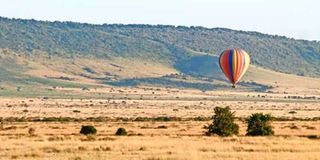Premium
A night under canvas in the Mara Triangle

A hot-air balloon floats by the Oloololo Escarpment. PHOTO | JAN FOX
What you need to know:
- The Triangle is a particularly scenic section of the reserve, with a high concentration of wildlife.
- There are also few lodges, so outside of the migration season the density of visitors is low.
- A herd of elephants grazes nearby, beneath the slim canopy of a lone acacia tree.
All around us, the plains are black and smouldering. The absence of long grass reveals a scattering of bones, and the bottoms of shrubs have been charred by flames.
Controlled fires stimulate growth before the rainy season, when hundreds of thousands of wildebeest make their frenetic journey into the Mara from the Serengeti.
We are heading west towards the Purungat Bridge, our entry point into the Mara Triangle. Wedged between the 400m high Oloololo Escarpment, and the meandering Mara River, the Triangle is a particularly scenic section of the reserve, with a high concentration of wildlife.
LODGES
There are also few lodges, so outside of the migration season the density of visitors is low.
Beyond the bridge we drive north along the river, through rich red oat grasslands. The vegetation is thicker here than in other parts of the reserve, and the landscape isn’t scarred by the tangle of tracks from off-roading vehicles.
A herd of elephants grazes nearby, beneath the slim canopy of a lone acacia tree. Through my binoculars I spot a tiny calf pressed against its mother, suckling — it can only be a few days old.
The midday sun starts to beat down through our roof hatch, so we seek the shade of our campsite. There are three public campsites across the Triangle, one in the northern corner of the reserve by the Oloololo Gate, and two near the Mara Serena Lodge — called Iseiya and Eluai.
PROTECTED
The Iseiya campsite is well protected within a dense thicket of trees, but we opt for the more exposed Eluai, high up on a ridge with sweeping views of the plains below. A patch of orange-leaf croton bushes provides the ideal cover for our tent.
We try as best we can to blend into our surroundings, but a huge gazebo we borrowed stands out like a bright red beacon in a sea of green.
The cool evening air is a welcome respite from the day’s heat. The sun has long descended behind the Oloololo Escarpment, but the plains beneath us are illuminated by the pale glow of a full moon. Throughout the night the stillness is pierced by a cacophony of wild noises: the deep belly “laughter” of hippos grazing far from the Mara River, the trumpeting of elephants, and the unsettling whooping of hyenas.
MINIBUSES
The following morning we leave camp at 5.45am, before the inevitable troop of minibuses blots the landscape. We feel like we have the reserve to ourselves, but the illusion is soon broken by the flickering flame of a hot-air balloon on the horizon.
In the heart of the Triangle, scattered balanites trees appear to float on a blanket of mist. Suddenly, out of the ghostly grey light emerges the silhouette of a lion’s mane.
He’s not alone — a lioness sleeps deeply by his side. He’s agitated, scratching the dirt and circling her. She’s clearly not in the mood.
He then lifts his head, pauses, and lets out the most bone-shaking of roars. We are just a few metres away, and can’t help but freeze in awe as it pulses through us. It’s impressive, yet truly terrifying. Another male responds somewhere in the mist behind us. The lioness is now awake.
She continues to reject his advances, until another female strides out of the long grass nearby. This seems to spur them on, and they finally mate in a blitz of growling and biting, before he flops on the ground and rolls around in the grass like a playful cub.
At the base of the escarpment behind them a hot-air balloon drifts silently by. Dawn has barely broken and we find ourselves, once again, ensnared by Mara’s magic.
To find out more about the Triangle and the available camping options, head to www.maratriangle.org.
Jan Fox is a director at iDC. Email: [email protected]





